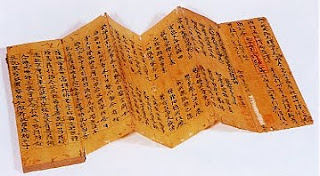
These are also known as pouch books because they are folded at the fore edge and sewn at the back edge, forming a pouch. The pages are first folded with the writing on the outside of the fold. The open ends of the paper are then sew with an inner binding to hold the paper together while the binding operation takes place, and to keep the book together if the binding proper falls apart. The outer binding is used by making 4 holes (for the more common Chinese version, or 5 for the Korean), and then sewn in the pattern observed to the left. The ends of the thread are secured with glue or can be tied in the more western fashion.


Retchoso
More commonly known as a multisectioned book is unique to Japan. The pages are folded into section or folios, and are then sewn together. Although, rather then stiching through small holes, the string is passed through small lateral slits. This allows the pages to lie flat when opened.




